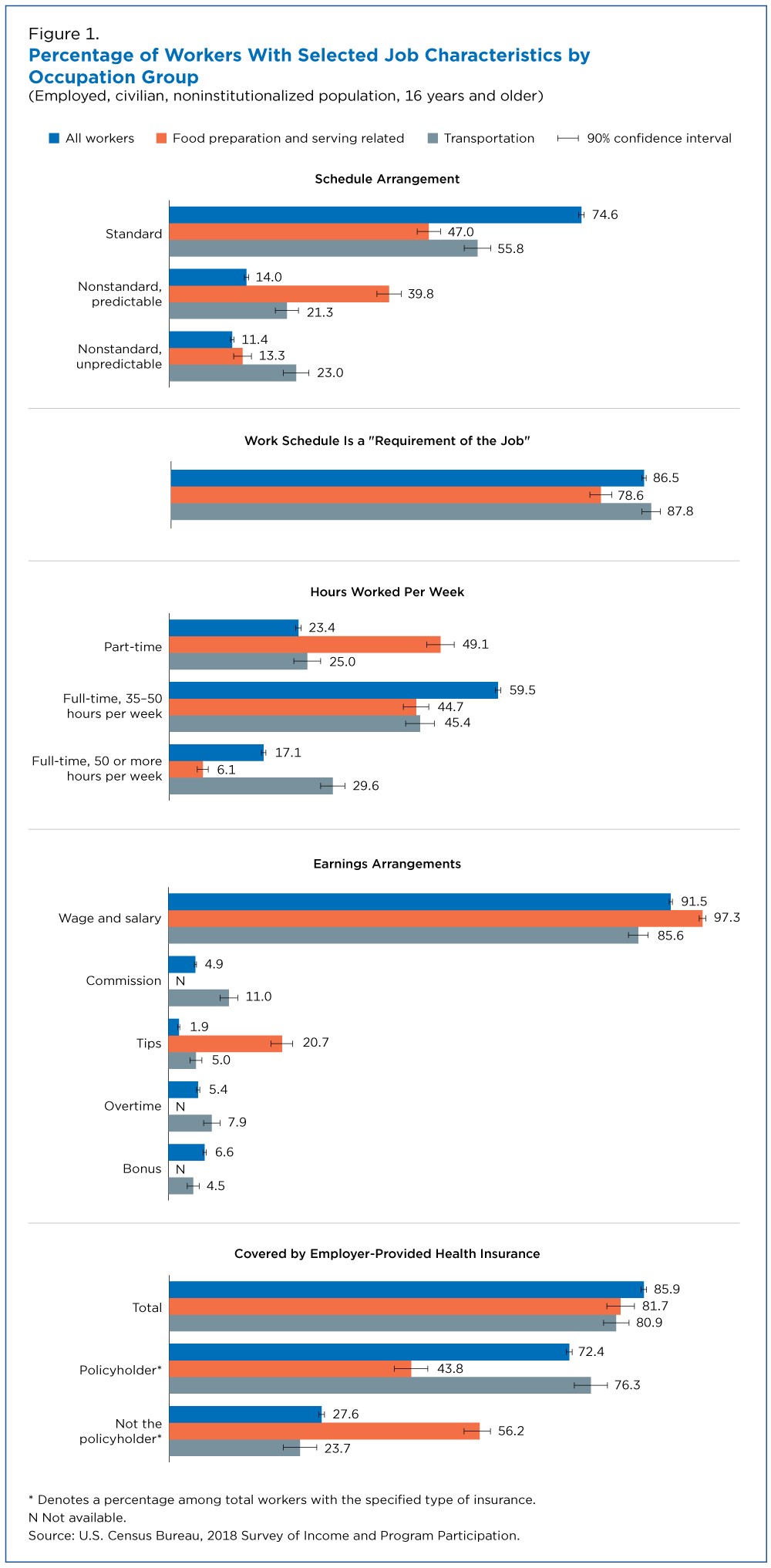Two Occupations Hard Hit During COVID Had Low Benefits, Earnings Even Before Pandemic
The COVID-19 pandemic has had widespread and uneven effects on U.S. workers, resulting in changes in employment, schedules and hours worked. That also meant changes in earnings and benefits.
Especially hard-hit were workers in food preparation and serving related occupations and in transportation. As recent studies have shown, lockdowns and other safety measures led to declines in full-time, year-round employment and increased unemployment.
While the impact of COVID-19 on jobs has yet to be fully explored, a recently released Census Bureau report can serve as a pre-pandemic benchmark for changes in job characteristics across occupation groups.
Here, 2018 Survey of Income and Program Participation (SIPP) data was used to highlight job characteristics for the two groups whose jobs and income would be among the most disrupted by the pandemic: food preparation and serving related occupations, and transportation occupations.
Even before the pandemic, those employed in food preparation and serving related occupations worked fewer hours on average than workers in other jobs. About half (49.1%) worked part-time or fewer than 35 hours per week.
Food Preparation and Serving Related Occupations
In 2017, 5.4% of U.S. workers (about 8.3 million) were employed in food preparation and serving related occupations.
About 75% of workers across all occupations had standard, daytime schedules, compared with 47% of food preparation and serving related workers.
Those in the food prep and serving jobs were more likely to have nonstandard schedule arrangements. For instance, 39.8% had nonstandard but predictable work schedules such as regular evening or night shifts, rotating shifts or split shifts. But 13.3% had nonstandard, unpredictable work schedules.
The SIPP asks workers to select the main reason for their reported schedule arrangement from a list of involuntary or voluntary reasons like job requirement or childcare needs.
Workers in food preparation and serving related jobs were among the least likely of all occupation groups to report their schedule was a requirement of the job.
Even before the pandemic, those employed in food preparation and serving related occupations worked fewer hours on average than workers in other jobs. About half (49.1%) worked part-time or fewer than 35 hours per week.
While 59.5% of all workers worked between 35 and 50 hours a week in 2017, only 44.7% of food preparation and serving related workers did. And only 6.1% worked 50 hours or more — among the lowest of all other occupation groups.
High rates of part-time work likely contributed to lower median monthly income. For example, in 2017 median monthly earnings across all occupations was $3,236. Yet food preparation and serving related workers’ median monthly earnings of $1,590 were about half that amount.
The 2018 American Community Survey (ACS) also shows several jobs within the broader occupation group were among the lowest-paid. Among them: hosts and hostesses, restaurant, lounge, and coffee shop; fast-food and counter workers; dishwashers; and dining room and cafeteria attendants and bartender helpers.
In the SIPP, workers can report multiple earnings types, sometimes in combination: 97.3% of food preparation and serving related workers earned a wage or salary, and 20.7% reported earnings from tips, an unpredictable source of income.
Earnings paid to employees are only one component of a worker’s total compensation. In addition, employers may offer nonwage benefits like paid leave, retirement plans, and health insurance.
Because the SIPP collects detailed information on individuals’ health insurance, it can be used to identify those who receive employer-provided health insurance.
Among workers with private health insurance coverage, 81.7% of those in food preparation and serving related occupations were covered by their own or another person’s employer-provided health insurance plan. The remaining 18.3% were covered by other sources of private health insurance such as a former employer, school, union or association or direct purchase.
However, most food preparation and serving related workers covered by employer-provided health insurance received coverage through the employer of another household member or relative. Only 43.8% were policyholders. In contrast, 72.4% of all workers in all occupations who were covered by employer-provided health insurance were policyholders.
Transportation Occupations
Transportation occupations comprise a diverse group of jobs including bus drivers, truck drivers, aircraft pilots, flight attendants, and many others. In 2017, there were about 5.7 million transportation workers in the United States, accounting for 3.7% of the employed population.
Like food preparation and serving related workers, significantly fewer workers in transportation occupations had standard schedules compared with the broader workforce (55.8% v. 74.6%).
Other schedule arrangements were also common among transportation workers: 21.3% had a nonstandard, predictable schedule and 23.0% had a nonstandard, unpredictable work schedule. The share of transportation workers with nonstandard, predictable work schedules was not significantly different from the share with nonstandard, unpredictable schedules.
Most transportation workers (87.8%) indicated their schedule arrangement was a requirement of their job.
About 75% of workers in transportation occupations were employed full-time or 35 hours or more a week, which was not statistically different from the share of all full-time workers across all occupations.
And long hours were not uncommon among transportation workers: 29.6% reported working 50 hours or more a week compared to 17.1% of all workers.
Transportation workers’ median monthly earnings ($2,999) were lower than those for all workers. The majority (85.6%) of transportation workers also received their earnings from a wage or salary, and significantly fewer had earnings from commission (11%), tips (5%), overtime (7.9%) or bonuses (4.5%).
Among workers with private health insurance, a smaller share (80.9%) of transportation workers were covered by employer-sponsored plans than all workers (85.9%). About 19% were covered by other sources of private health insurance.
Yet a larger share were policyholders: 76.3% of transportation workers covered by employer-sponsored health insurance were policyholders, compared to 72.4% of all workers and 43.8% of food preparation and serving related workers.
What is the SIPP?
The Survey of Income and Program Participation is a nationally representative longitudinal survey administered by the U.S. Census Bureau that provides comprehensive information on the dynamics of income, employment, household composition and government program participation.
For more information about SIPP data quality, please visit the SIPP Technical Documentation page.
Related Statistics
Stats for Stories
Stats for Stories
Subscribe
Our email newsletter is sent out on the day we publish a story. Get an alert directly in your inbox to read, share and blog about our newest stories.
Contact our Public Information Office for media inquiries or interviews.







